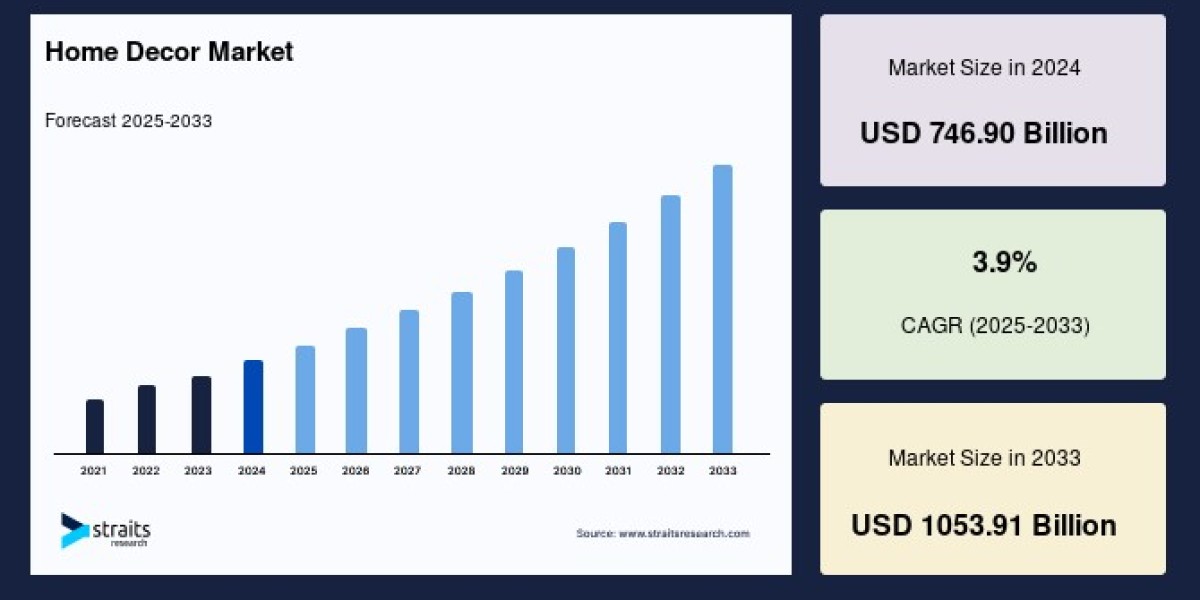Introduction
The global home decor market size was valued at USD 746.90 billion in 2024 and is projected to reach from USD 776.03 billion in 2025 to USD 1053.91 billion by 2033, growing at a CAGR of 3.9% during the forecast period (2025-2033). The growth of the market is attributed to increasing consumer interest in home decor and rising urbanization worldwide.
Market Overview
The global home decor market has witnessed consistent growth, underpinned by rising consumer interest in stylish living spaces and enhanced home environments. The market recently reached a substantial valuation, buoyed by strong demand across developed and emerging economies. Notably, Asia-Pacific stands as the largest regional market, while Europe is expected to grow at a robust pace in the coming years.
Several factors underpin this positive trajectory. The surge in small, urban homes has increased demand for multifunctional and aesthetically pleasing products that maximize both space and style. Moreover, heightened environmental consciousness is fuelling a shift toward eco-friendly materials and products, directly influencing purchase decisions worldwide.
Key Growth Drivers
Urbanization and Demographic Shifts
Urbanization is a leading catalyst shaping home decor trends around the globe. As populations concentrate in cities, there is a greater demand for modern, functional decor solutions tailored to smaller living spaces. Regions like Asia and Africa, though still less urbanized than North America and Europe, are experiencing rapid urban growth—heralding new avenues for market expansion. This trend is particularly pronounced in countries such as India and China, where rising income levels and booming real estate sectors are creating a burgeoning consumer base for home decor.
Rising Disposable Income and Lifestyle Innovation
Economic growth in various regions has led to an increase in disposable income, which in turn enhances spending on home improvement. Consumers are now more inclined to invest in home decor products ranging from furniture and textiles to floor coverings. Innovations in modular design, space-saving furniture, and smart interior solutions are being rapidly adopted, especially as hybrid working arrangements normalize the demand for home offices and multifunctional interiors.
The Shift Toward Eco-Friendly Solutions
Eco-friendly and sustainable decor products are gaining traction, driven by increased environmental awareness. Products created from renewable, recycled, or certified sustainable materials—such as reclaimed wood, low-VOC finishes, and energy-efficient accessories—are resonating with conscious buyers. This trend is especially prevalent in developed economies but is steadily permeating emerging markets as well.
Market Segmentation
By Product
The home decor market includes a diverse portfolio of products such as furniture, textiles, and floor coverings. The floor covering segment remains the highest contributor, propelled by innovative products like eco-friendly tiles, laminate, and recycled materials. Furniture continues to be in high demand, favored for its role in facilitating modern living concepts, such as modular kitchens and versatile seating.
By Distribution Channel
Specialty stores command the largest market share, thanks to their expertise in offering tailored solutions and premium customer experiences. Supermarkets and hypermarkets also constitute significant distribution channels, leveraging large inventories and competitive pricing. The advent of e-commerce has catalyzed market growth further by providing consumers with greater convenience, access to a broad range of products, and immersive technologies like augmented and virtual reality for personalized online shopping.
Regional Insights
Asia-Pacific: The Dominant Force
Asia-Pacific holds the leading position in the home decor market due to rapid urbanization, swelling middle-class populations, and a thriving real estate sector. China, in particular, accounts for a major share of furniture sales, driven by a combination of expanding disposable incomes and evolving consumer tastes. Lifestyle improvements and increased rates of home ownership are further stimulating market activity.
Europe: Fastest-Growing Market
Europe is on track to achieve robust growth, driven by consumer preferences for premium designs, multifunctional furniture, and adherence to stringent quality standards. The region's affinity for high-end, stylish products fuels demand, while the commercial application of home decor, such as specialized hospital and institutional furniture, adds further momentum.
North America and LAMEA
North America presents a mature market with a marked consumer preference for eco-friendly and luxury home decor products. Regulatory restrictions on hazardous materials and heightened sustainability awareness are furthering eco-conscious purchasing behavior. The LAMEA region (Latin America, Middle East, Africa) is characterized by a rising middle class and increasing urbanization, paving the way for future market expansion, especially as furniture production facilities migrate to these regions to leverage resource availability.
Challenges and Opportunities
Despite its promising growth outlook, the home decor market faces several challenges. Economic volatility, inflation, and supply chain disruptions are pressuring prices and consumer purchasing power. Raw material shortages and intense competition among retailers also restrict profitability. However, opportunities abound in digital expansion, product innovation, and the rise of sustainable offerings.
Premiumization, customization, and the integration of technology in retail and product design are expected to further invigorate the market. As consumers increasingly seek multifunctional, sustainable, and personalized home environments, brands that align with these aspirations are well-positioned for growth.
Conclusion
The global home decor market is set to sustain its upward trajectory, shaped by demographic trends, economic factors, and changing consumer values. As urbanization accelerates and eco-friendly awareness grows, companies that blend innovation with sustainability and engage consumers across dynamic channels will be poised to lead the next chapter of home decor evolution.












